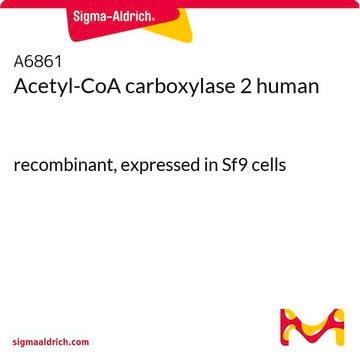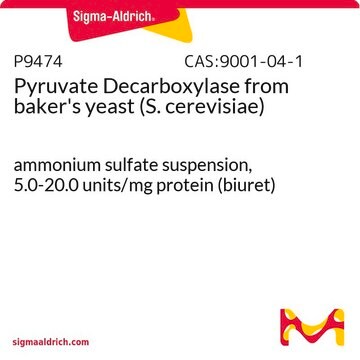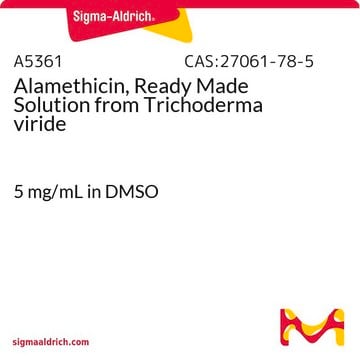A6986
Acetyl-CoA Carboxylase 1 human
recombinant, expressed in Sf9 cells
Synonym(s):
ACAC, ACACA, ACC, ACC1, ACCA, acetyl-CoA carboxylase alpha
Sign Into View Organizational & Contract Pricing
All Photos(1)
About This Item
Recommended Products
General description
Acetyl-CoA Carboxylase 1 (ACACA) is mapped to human chromosome 17q12. It is majorly expressed in liver and adipose tissue. ACACA has biotin carboxylase (BC), biotin carboxyl carrier protein (BCCP) and carboxyl transferase (CT) domains and an additional interaction domain. (BT) A central domain region (CD) connects the BC and CT domains. ACACA is a key regulator of energy balance. The ACACA catalysis is the rate-limiting step in the synthesis of malonyl-CoA and regulation of free fatty acid oxidation. Elevated levels of ACACA contributes to obesity and tumor progression.
Formulation: Solution in Tris-HCl (pH 8), NaCl, Glycerol
Application
Useful for the study of enzyme kinetics, screening inhibitors, and selectivity profiling.
Biochem/physiol Actions
Acetyl-CoA Carboxylase (ACC) regulates the metabolism of fatty acids. This enzyme catalzes the formation of Malonyl CoA through the irreversible carboxylation of acetyl CoA. There are two main isoforms of Acetyl-CoA carboxylase expressed in mammals, Acetyl-CoA carboxylase 1 (ACACA) and Acetyl-CoA carboxylase 2 (ACACB). ACACA has broad tissue distribution but is enriched in tissues critical for fatty acid sythesis such as adipose tissue. ACACB is enriched in tissues such as skeletal muscle and heart that are critical for fatty acid oxidation.
The Acetyl-CoA Carboxylase enzymes are activated by citrate, glutamate, and dicarboxylic acids and negatively regulated by long and short chain fatty acyl CoAs. Acetyl-CoA Carboxylase 1 is essential for breast cancer and prostrate cancer cell survival. Because of thier roles in fatty acid metabolism and oxidation, ACACA and ACACB are therapeutic targets for treating obesity and metabolic syndrome disorders.
The Acetyl-CoA Carboxylase enzymes are activated by citrate, glutamate, and dicarboxylic acids and negatively regulated by long and short chain fatty acyl CoAs. Acetyl-CoA Carboxylase 1 is essential for breast cancer and prostrate cancer cell survival. Because of thier roles in fatty acid metabolism and oxidation, ACACA and ACACB are therapeutic targets for treating obesity and metabolic syndrome disorders.
Physical properties
α transcript variant 1, C-terminal histidine-tagged 270 kDa protein containing amino acids 1-2383 (end)
Unit Definition
One unit will cause the conversion of 1 picomole of ATP to ADP per minute at pH 7.4 at 30 °C
Preparation Note
Thaw on ice. Upon first thaw, briefly spin tube containing enzyme to recover full content of the tube. Aliquot enzyme into single use aliquots. Store remaining undiluted enzyme in aliquots at -70°C. Note: Enzyme is very sensitive to freeze/thaw cycles.
Storage Class Code
12 - Non Combustible Liquids
WGK
WGK 1
Flash Point(F)
Not applicable
Flash Point(C)
Not applicable
Certificates of Analysis (COA)
Search for Certificates of Analysis (COA) by entering the products Lot/Batch Number. Lot and Batch Numbers can be found on a product’s label following the words ‘Lot’ or ‘Batch’.
Already Own This Product?
Find documentation for the products that you have recently purchased in the Document Library.
Structural basis for regulation of human acetyl-CoA carboxylase
Hunkeler M, et al.
Nature, 558, 470-474 (2018)
Regulation of acetyl CoA carboxylase and carnitine palmitoyl transferase-1 in rat adipocytes
Zang Y, et al.
Obesity Research, 13(9), 1530-1539 (2005)
Jorgen F P Wojtaszewski et al.
American journal of physiology. Endocrinology and metabolism, 284(4), E813-E822 (2002-12-19)
The metabolic role of 5'AMP-activated protein kinase (AMPK) in regulation of skeletal muscle metabolism in humans is unresolved. We measured isoform-specific AMPK activity and beta-acetyl-CoA carboxylase (ACCbeta) Ser(221) phosphorylation and substrate balance in skeletal muscle of eight athletes at rest
Kalyan K Sadhu et al.
Journal of the American Chemical Society, 134(49), 20013-20016 (2012-11-29)
The photoreduction of azide-based immolative linker by Ru(II) conjugates to uncage rhodamine was achieved using different oligomeric protein templates. The generality of the approach was validated with three sets of ligand having varying affinity to their target (biotin, desthiobiotin and
Graeme J Gowans et al.
Cell metabolism, 18(4), 556-566 (2013-10-08)
While allosteric activation of AMPK is triggered only by AMP, binding of both ADP and AMP has been reported to promote phosphorylation and inhibit dephosphorylation at Thr172. Because cellular concentrations of ADP and ATP are higher than AMP, it has
Articles
Fatty acid synthesis supports cancer cell proliferation, essential for membrane generation, protein modification, and bioenergetics.
Our team of scientists has experience in all areas of research including Life Science, Material Science, Chemical Synthesis, Chromatography, Analytical and many others.
Contact Technical Service








